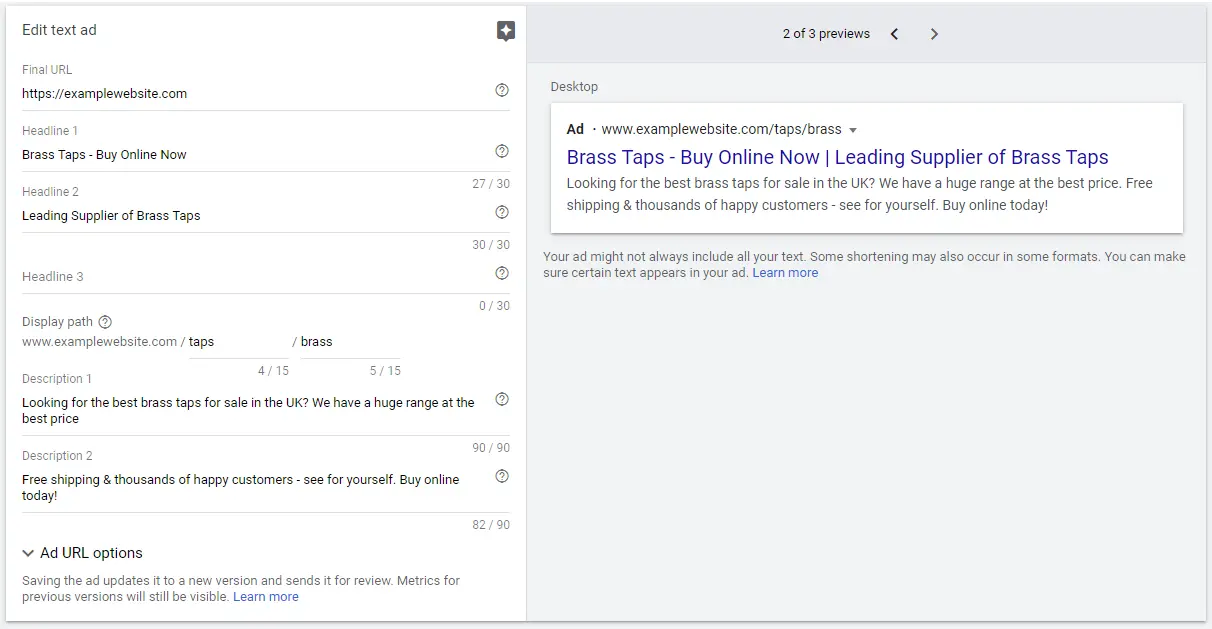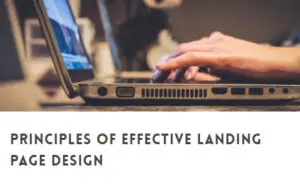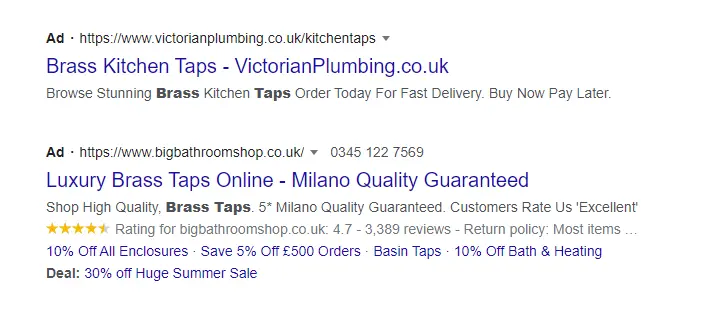Once you’ve got your Google Ads account created and set up, it’s time to write some kick-ass adverts! But how do you get started and how on earth do you know what to put in your ads?
This blog post is going to focus on expanded text ads. These are the most common kinds of Google Ads and the ones that you’ll see on the search results pages. But the same theory can be applied to responsive ads (which are pretty much the same in how you create them, you just add more headlines and descriptions and Google picks a combination it thinks works best for that searcher), as well as any other ad you might need to write for other advertising platforms.
What makes up a Google text ad?
Headlines
This is the most prominent part of your advert. It’s what potential customers see first and there’s a good chance it’ll have the biggest impression on the people viewing your ads.
It should state clearly what your business is, or what the product or service is you’re offering.
You get three headlines, although it’s not often that you see three in the final advert. I normally tend to focus on the first two. These have a 30 character limit. You can almost guarantee that what you want to say will be exactly 31 characters. It’s always the way!
Description Lines
You have two of these, with a 90 character limit. Use these to expand on the offering and why the customer should visit your website.
Final URL
This is the page visitors land on when they click your ad. Make sure it’s as relevant as possible to the product or service you’re advertising.
Tip 1: Relate to your customers
Think about what your customers needs. When and why are they looking for your product or service? Who is your main demographic? What are they hoping to gain by purchasing your product or using your services? Why do your current customers love you?
By understanding why people use your products or services, you’ll be able to use language that resonates with potential customers. Create statements that connect deeply with your target audience and call to actions that they understand and want to engage with.
Tip 2: Stand out from the crowd
You might be tempted to look at what others are saying in their adverts and mimic that. You could do that, but that’s not going to help your advert stand out.
Instead, think about what makes your company unique. What key things do your existing customers love about you? How are you different from your competitors? What extra things do you offer – free delivery, custom packages, free training, expert advice? Make sure you include these things in your adverts.
If you’re writing an ad for a current promotion, ensure it’s very clear what the promotion is. Tell customers that they can save 50%, or take advantage of a 3 for 2 offer.
Tip 3: Use strong call-to-actions
When writing an advert you need to think about what you want the potential customer to do after clicking on your ads. These are called ‘call-to-actions’. Some common ones include:
- Shop now
- Place your order
- Book now
- Buy today
- Learn more
- Call us no
- Sign up
- Download
- Get a quote
These are specific things you want the customer to do as part of the next step. They can also provide a sense of urgency by using words like ‘now’ or ‘today’.
If you are creating an ad for a specific offer, you can include something like ‘July only’, or ‘Offer ends on July 31st’. You can even use an automated countdown by inserting a countdown customizer code.
Tip 4: Be specific
Your ad needs to be clear on what the customers will find on your website once they’ve clicked. This is why it’s important to have a really good, strong, clear landing page.
For more tips on crafting excellent landing pages, read these posts:
It’s best practice to write specific ads for each ad group. That way your advert will match closely to the keywords in that group and to the page you’re directing people to.
So keep your adverts focused on just one product or service. If people are searching for brass taps, make sure you have an advert focused on brass taps, and take them to your brass taps landing page. Then create another ad group with its own set of adverts for your nickel taps, chrome taps, stainless steel taps etc.
Tip 5: Be direct
You only have a small amount of space in which to get the message across. Just two 30 character headlines and two 90 character description lines. These also can’t be combined, so you need two separate headlines and two different descriptions. The decription lines are split with a full stop, so you can’t roll the text over.
So you need to get to the point. Plus people scan adverts, they don’t often read every single word. You need to make sure your advert quickly and clearly tells people what it is you’re offering and why they should click on your advert over any of the others.
Tip 6: Use your keywords
If you’re bidding on the keyword ‘brass taps’, then make sure you use those keywords in your advert. These terms will be made bold by Google automatically, so they’ll help your advert to stand out.
Use them in the headlines, descriptions, and URL path if you can. But make sure your advert still makes sense. Don’t be spammy about it!
You can use a keyword insertion code in your adverts to help with this. For example, by adding {KeyWord:Brass Taps} in your headline text, your advert will use the keyword the searcher used, so if they typed in ‘Buy brass taps’, your advert headline will be ‘Buy Brass Taps’. If the searcher used a search phrase that was over the 30 character limit (such as ‘buy brass taps in Hampshire), then your ad will revert to the default text you set – ‘Brass Taps’.
Tip 7: Check for typos
It sounds obvious, but it’s very easy to make spelling mistakes, typos, and grammatical errors. Especially when you’re creating lots of ads. Or when you’re struggling to find the words to say within the character limit.
Likewise, avoid excessive punctuation and capitalisation. Google is quite strict about this sort of stuff, so make sure your ads comply with their ad guidelines.
Make sure you give all the ads a once-over before you make them live.
Tip 8: Test, test, and test again!
There’s no golden rule to follow when creating ads. What you think might be the perfect ad might not resonate well with your customers. The only way to know if is by trial and error. Hopefully not too much error though!
Aim to have three ads in even rotation in each ad group. Test the headlines, call to actions, sentence case structure, and phrasings. Don’t change too much up at once though, or you won’t know what it is that’s worked or not worked.
- How to Do Keyword Research for Google Ads - January 15, 2024
- A Comprehensive Guide to Google Ads for B2C Businesses - January 8, 2024
- How to Write Calls to Action (CTAs) for Google Ads - December 25, 2023












